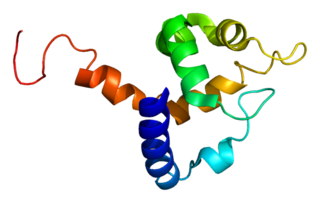Nudix hydrolase 15 is a protein that in humans is encoded by the NUDT15 gene. [5]
Nudix hydrolase 15 is a protein that in humans is encoded by the NUDT15 gene. [5]
The NUDT15 gene encodes an enzyme that belongs to the Nudix hydrolase superfamily. Members of this superfamily catalyze the hydrolysis of nucleoside diphosphates, including substrates like 8-oxo-dGTP, which are a result of oxidative damage, and can induce base mispairing during DNA replication, causing transversions. The encoded enzyme is a negative regulator of thiopurine activation and toxicity. Mutations in this gene result in poor metabolism of thiopurines, and are associated with thiopurine-induced early leukopenia. Multiple pseudogenes of this gene have been identified.
NUDT15 germline variants (e.g., a missense SNP:rs116855232, inducing R139C) have been linked to clinical usage of thiopurines (e.g., mercaptopurine) in acute lymphoblastic leukemia [6] [7] as well as inflammatory bowel diseases to avoid thiopurine-induced leukopenia. [8] [9] These variants also exhibit ethnicity-specific (e.g., variant allele of rs116855232 is high is East Asians and Hispanics but low in Caucasians and Africans). Rare functional variants in this gene have also been identified as being related to thiopurine-induced myelotoxicity, [10] suggesting the whole gene screening should be taken to determine the initial dosage using of thiopurine.

Azathioprine, sold under the brand name Imuran, among others, is an immunosuppressive medication. It is used for the treatment of rheumatoid arthritis, granulomatosis with polyangiitis, Crohn's disease, ulcerative colitis, and systemic lupus erythematosus; and in kidney transplants to prevent rejection. It is listed by the International Agency for Research on Cancer as a group 1 human carcinogen. It is taken by mouth or injected into a vein.

Mercaptopurine (6-MP), sold under the brand name Purinethol among others, is a medication used for cancer and autoimmune diseases. Specifically it is used to treat acute lymphocytic leukemia (ALL), acute promyelocytic leukemia (APL), Crohn's disease, and ulcerative colitis. For acute lymphocytic leukemia it is generally used with methotrexate. It is taken orally.

Thiopurine methyltransferase or thiopurine S-methyltransferase (TPMT) is an enzyme that in humans is encoded by the TPMT gene. A pseudogene for this locus is located on chromosome 18q.

Tioguanine, also known as thioguanine or 6-thioguanine (6-TG) or tabloid is a medication used to treat acute myeloid leukemia (AML), acute lymphocytic leukemia (ALL), and chronic myeloid leukemia (CML). Long-term use is not recommended. It is given by mouth.

The thiopurine drugs are purine antimetabolites widely used in the treatment of acute lymphoblastic leukemia, autoimmune disorders, and organ transplant recipients.

MN1 is a gene found on human chromosome 22, with gene map locus 22q12.3-qter. Its official full name is meningioma 1 because it is disrupted by a balanced translocation (4;22) in a meningioma.

Histone-lysine N-methyltransferase 2A, also known as acute lymphoblastic leukemia 1 (ALL-1), myeloid/lymphoid or mixed-lineage leukemia1 (MLL1), or zinc finger protein HRX (HRX), is an enzyme that in humans is encoded by the KMT2A gene.

Hepatic leukemia factor is a protein that in humans is encoded by the HLF gene.

Rhombotin-1 is a protein that in humans is encoded by the LMO1 gene.

K(lysine) acetyltransferase 6A (KAT6A), is an enzyme that, in humans, is encoded by the KAT6A gene. This gene is located on human chromosome 8, band 8p11.21.

Bis(5'-nucleosyl)-tetraphosphatase [asymmetrical] is an enzyme that in humans is encoded by the NUDT2 gene.

T-cell leukemia homeobox protein 3 is a protein that in humans is encoded by the TLX3 gene.

Protein kinase C and casein kinase substrate in neurons protein 2 is a protein that in humans is encoded by the PACSIN2 gene. Pacsin 2 is involved in the formation of caveolae.

Phosphatidylinositol binding clathrin assembly protein, also known as PICALM, is a protein which in humans is encoded by the PICALM gene.

PHD finger protein 6 is a protein that in humans is encoded by the PHF6 gene.

Histone-lysine N-methyltransferase 2D (KMT2D), also known as MLL4 and sometimes MLL2 in humans and Mll4 in mice, is a major mammalian histone H3 lysine 4 (H3K4) mono-methyltransferase. It is part of a family of six Set1-like H3K4 methyltransferases that also contains KMT2A, KMT2B, KMT2C, KMT2F, and KMT2G.

Aldehyde dehydrogenase 1 family, member A2, also known as ALDH1A2 or retinaldehyde dehydrogenase 2 (RALDH2), is an enzyme that in humans is encoded by the ALDH1A2 gene.

AT-rich interactive domain-containing protein 5B is a protein that in humans is encoded by the ARID5B gene.

Diphosphoinositol polyphosphate phosphohydrolase 1 is an enzyme that in humans is encoded by the NUDT3 gene.

T-cell acute lymphocytic leukemia 2, also known as TAL2, is a protein which in humans is encoded by the TAL2 gene.
This article incorporates text from the United States National Library of Medicine, which is in the public domain.